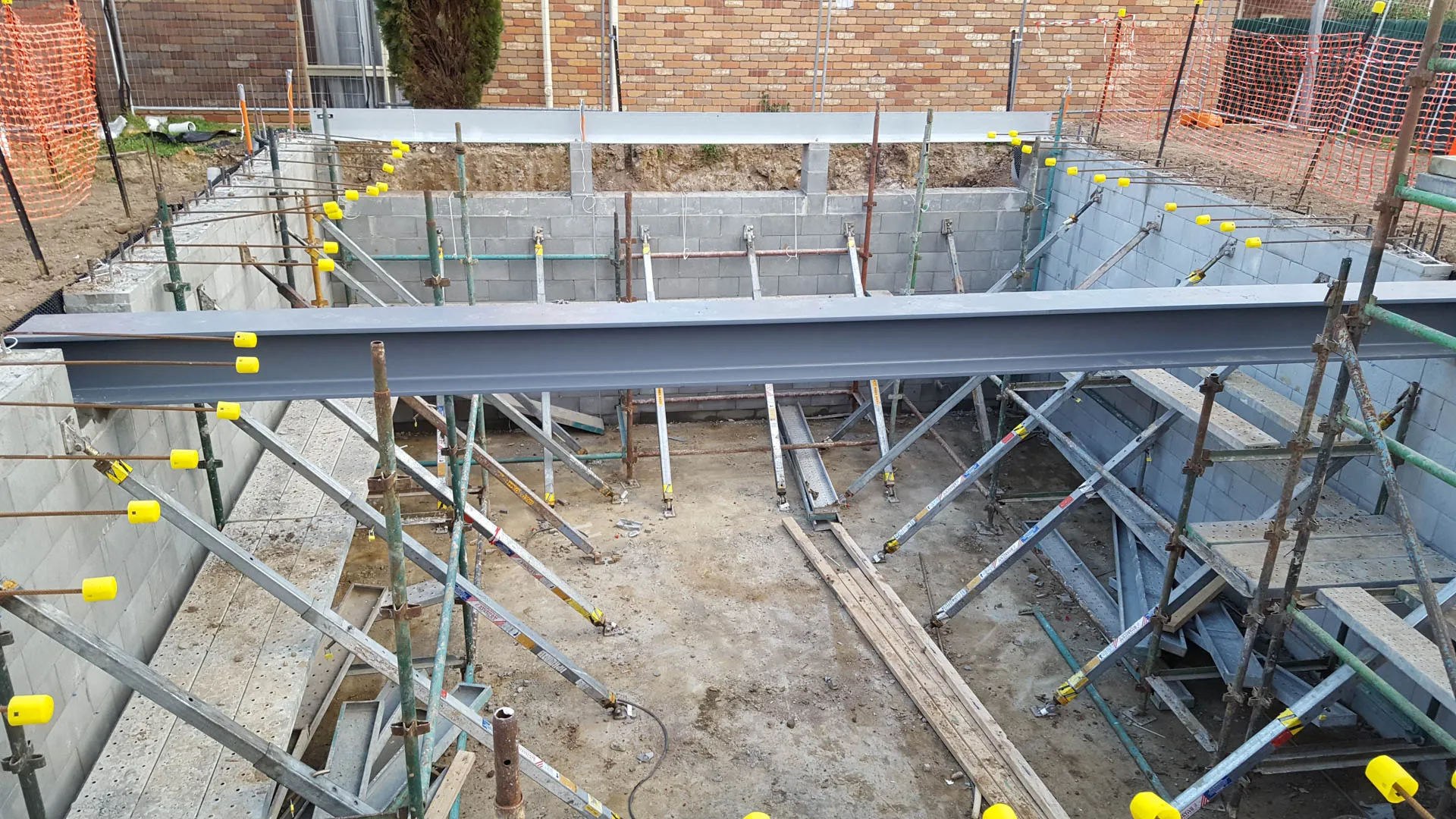Building a basement is a significant undertaking, but it doesn’t have to be a daunting one. With the right knowledge and planning, you can transform that underutilized space into a valuable extension of your home. Whether you’re envisioning a cozy living area, a functional home office, or a state-of-the-art entertainment hub, this comprehensive guide will equip you with the essential insights to navigate the world of basement construction.
Basement Construction Techniques: From Excavation to Finishing Touches
Before you get caught up in choosing paint colors and flooring, let’s start with the foundation – literally! Understanding the different construction methods and materials available is crucial for ensuring a structurally sound, dry, and comfortable basement that stands the test of time.
Building from the Ground Up (or Down!): Excavation and Construction Methods
The method you choose for excavating and constructing your basement will depend on factors such as your site conditions, budget, and the complexity of your design.
- Open-Cut Method:
- Ideal for: Flat lots with stable soil.
- Involves excavating a large hole, constructing the basement walls, and then backfilling around it.
- Vertical Cut Method:
- Ideal for: Sloped lots where retaining walls are necessary.
- Involves using retaining walls to hold back the soil while you excavate and build the basement in stages.
- Top-Down Method:
- Ideal for: Urban areas, deep basements, or where minimizing disturbance to the surrounding area is crucial.
- Involves constructing the ground floor first and then excavating and building the basement underneath it.
Materials Matter: Choosing the Right Walls for Your Basement
The materials you use for your basement walls will impact its strength, durability, moisture resistance, and overall cost.
- Poured Concrete:
- Pros: Strong, durable, naturally resistant to water, relatively quick to install.
- Cons: Requires a solid foundation, can be challenging to shape for unique designs.
- Concrete Blocks:
- Pros: Versatile, cost-effective in some cases, provides good insulation.
- Cons: More labor-intensive, requires skilled masons, may need additional finishing.
- Prefabricated Sections (Precast Concrete):
- Pros: Super-fast construction, high-quality control, often energy-efficient with built-in insulation.
- Cons: Less design flexibility, requires specialized equipment for installation, cost can be higher.
Finishing Touches: Transforming Your Basement into a Livable Space
Once the basic structure is in place, it’s time to focus on creating a comfortable and inviting living space.
- Insulation:
- Essential for regulating temperature, reducing energy costs, and preventing condensation.
- Consider insulation options for walls, ceilings, and even under the basement floor.
- Sealing Cracks:
- Use waterproof caulk and sealants to close any gaps or cracks in the walls, floors, and around windows and doors.
- Prevents moisture intrusion, drafts, and pests.
- Framing:
- Allows for dividing the basement into separate rooms and provides a framework for drywall, creating a finished look.
Taking it to the Next Level: Advanced Techniques for Challenging Projects
For complex projects with unique soil conditions or structural requirements, advanced construction techniques might be necessary.
- Diaphragm Walls:
- Extremely strong reinforced concrete walls used in deep excavations to hold back significant pressure from water or unstable soil.
- Secant Piling:
- Involves interlocking concrete or steel beams to create a continuous, watertight wall, often used for underground parking garages or basements in areas with high water tables.
- Jet Grouting:
- A technique that injects a special grout mixture into the soil at high pressure, solidifying it and creating an incredibly strong foundation.
Don’t Forget the Important Stuff!
Before you finalize your basement construction plans, consider these important factors:
- Sustainability:
- Opt for eco-friendly materials, such as recycled-content insulation or sustainable flooring options.
- Explore energy-efficient HVAC systems, like geothermal heating and cooling.
- Smart Home Integration:
- Incorporate smart home technology for lighting, temperature control, security, and even leak detection.
- Design Trends:
- Basements are no longer just for storage; think creatively and transform yours into a home theater, a gym, a guest suite, or a combination of spaces that suit your lifestyle.
What are the Different Types of Basement Construction Methods? – A Closer Look
Choosing the right basement construction method is a crucial first step. Let’s revisit the most common types and explore their suitability for different projects.
Factors to Consider When Choosing a Basement Construction Method:
- Soil Conditions:
- The stability and drainage characteristics of your soil will significantly influence the excavation process and the type of foundation support required.
- Sub-soil Conditions:
- The presence of groundwater, bedrock, or other underground obstacles will impact the feasibility of different construction methods.
- Structure of the Basement:
- The size, shape, and design complexity of your basement will dictate the structural requirements and the most appropriate construction approach.
- Layout Requirement of the Building:
- The overall design and layout of your house will influence the basement’s placement and the excavation methods that are feasible.
Types of Basement Construction Methods:
- Poured Concrete:
- Description: Involves pouring concrete into forms to create the basement walls and floor.
- Ideal for: Projects where strength, durability, and water resistance are paramount.
- Considerations: Requires a well-prepared foundation and careful attention to waterproofing.
- Concrete Block:
- Description: Uses concrete blocks stacked and mortared together to build the basement walls.
- Ideal for: Projects where cost-effectiveness and insulation are priorities.
- Considerations: Can be more labor-intensive than poured concrete and may require additional finishing.
- Precast Panels:
- Description: Utilizes large, prefabricated concrete panels that are assembled on-site.
- Ideal for: Projects where speed of construction and precise engineering are essential.
- Considerations: Requires specialized equipment for transportation and installation and may offer less design flexibility.
How Much Does Basement Construction Cost? – Factors & Considerations
The cost of basement construction can vary greatly depending on a wide range of factors. Understanding these cost drivers will help you establish a realistic budget and avoid unwelcome surprises.
Factors Impacting Basement Construction Costs:
- Location and Size:
- Larger basements in areas with higher construction costs will generally be more expensive.
- Permits and Inspections:
- Factor in the cost of obtaining building permits, scheduling inspections, and complying with local building codes.
- Materials:
- The quality and type of materials you choose for flooring, fixtures, appliances, and finishes will significantly influence the overall cost.
- Labor:
- Hiring skilled professionals like excavators, framers, electricians, and plumbers constitutes a significant portion of the budget.
- Waterproofing and Drainage:
- Investing in proper waterproofing and drainage systems is essential for preventing costly water damage in the future.
- Foundation Condition:
- If your existing foundation requires repairs or reinforcement, this will add to the overall project cost.
Additional Cost Considerations:
- DIY vs. Professional:
- Tackling some tasks yourself can save money but requires time, skill, and realistic expectations.
- Financing Options:
- Explore financing options like home equity loans or lines of credit to make your project more manageable.
- Return on Investment:
- A well-designed and finished basement can significantly increase your home’s value, offsetting some of the upfront costs.
Basement Waterproofing: Techniques & Best Practices
Waterproofing your basement is crucial for protecting your investment, ensuring a healthy living environment, and maximizing the usability of your new space.
Identifying and Addressing Water Entry Points:
- Foundation Cracks: Even hairline cracks can allow water to seep in, so it’s crucial to seal them with epoxy or hydraulic cement.
- Mortar Joints: Over time, mortar joints can deteriorate, creating pathways for water entry. Repointing or sealing these joints is essential.
- Window Wells: Improperly installed or maintained window wells can collect water and direct it towards your basement.
- Pipes and Plumbing: Leaks in plumbing pipes or drainage systems can lead to significant water damage if left unaddressed.
Establishing Effective Drainage:
- Gutters and Downspouts: Ensure your gutters are clean and free of debris, and that downspouts direct water away from your foundation.
- French Drains: These underground trenches, filled with gravel and perforated pipe, collect and redirect groundwater away from your basement.
- Sump Pumps: A sump pump sits in a basin and automatically pumps out water that collects there, preventing it from rising and flooding your basement.
Customizing Your Waterproofing Strategy:
- Exterior Waterproofing:
- Applying a waterproof membrane or sealant to the exterior of your foundation walls.
- Installing drainage boards to channel water away from the foundation.
- Often done during new construction or major renovations when access to the foundation is readily available.
- Interior Waterproofing:
- Sealing cracks and gaps in the walls and floors with epoxy or other waterproof materials.
- Installing interior drainage systems that collect water and direct it to a sump pump.
- Humidity Control:
- Installing vapor barriers to prevent moisture from evaporating up through the concrete floor.
- Using a dehumidifier to maintain a comfortable humidity level and prevent musty odors.
Reaping the Rewards of a Dry Basement:
- Peace of Mind: Enjoy your basement without the worry of water damage.
- Healthier Living: Eliminate the risk of mold and mildew growth, improving indoor air quality.
- Increased Home Value: A dry, usable basement is a major selling point for potential buyers.
- Additional Living Space: Transform your basement into a valuable extension of your living area.
Conclusion
Building a basement is an investment in your home’s comfort, functionality, and value. By understanding the key elements of basement construction, from excavation techniques to waterproofing strategies, you can embark on your project with confidence. Remember to consult with experienced professionals, prioritize quality materials, and don’t be afraid to let your creativity shine as you design and build the basement of your dreams.
Internal Links:
- Craft your dream road with our comprehensive guide to the step-by-step road construction process.
- Discover ingenious plans for a functional art studio that sparks creativity.
- Explore the intricate details of Kerala house building costs and plan your dream home.
- Glass Tiles for Kitchen: Style and Durability Tips - November 30, 2025
- Decorative Wall Tiles for Kitchen: Stylish Design Ideas - November 29, 2025
- Decorative Wall Tiles: Style Your Home with Unique Designs - November 28, 2025










